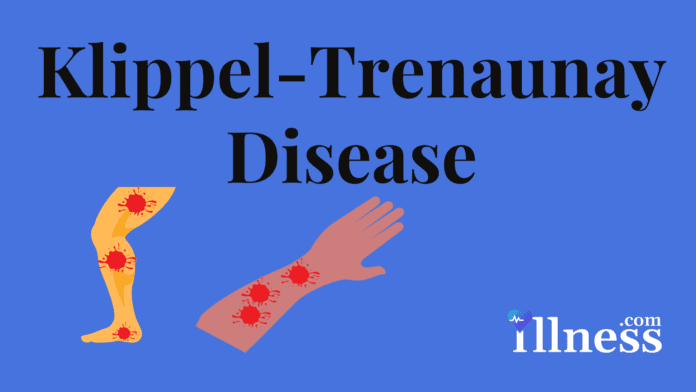Overview
Klippel-Trenaunay-Weber syndrome is a condition that affects the development of blood vessels, soft tissues (such as skin and muscles), and bones. The disorder has three characteristic features: a red birthmark called a port-wine stain, abnormal overgrowth of soft tissues and bones, and vein malformations.
Most people with it are born with a port-wine stain. This type of birthmark is caused by the swelling of small blood vessels near the surface of the skin. Port-wine stains are typically flat and can vary from pale pink to deep maroon in color. In people with Klippel-Trenaunay-Weber syndrome, the port-wine stain usually covers part of one limb. The affected area may become lighter or darker with age. Occasionally, port-wine stains develop small red blisters that break open and bleed easily.
Klippel-Trenaunay-Weber syndrome
Klippel-Trenaunay-Weber syndrome is also associated with the overgrowth of bones and soft tissues beginning in infancy. Usually, this abnormal growth is limited to one limb, most often one leg. However, an overgrowth can also affect the arms or, rarely, the torso. The abnormal growth can cause pain, a feeling of heaviness, and reduced movement in the affected area. If the overgrowth causes one leg to be longer than the other, it can also lead to problems with walking.
Malformations of veins are the third major feature of Klippel-Trenaunay-Weber syndrome. These abnormalities include varicose veins, which are swollen and twisted veins near the surface of the skin that often cause pain. Varicose veins usually occur on the sides of the upper legs and calves. Veins deep in the limbs can also be abnormal in people with Klippel-Trenaunay-Weber syndrome. Malformations of deep veins increase the risk of a type of blood clot called a deep vein thrombosis (DVT). If a DVT travels through the bloodstream and lodges in the lungs, it can cause a life-threatening blood clot known as a pulmonary embolism (PE).
Other complications of Klippel-Trenaunay syndrome can include a type of skin infection called cellulitis, swelling caused by a buildup of fluid (lymphedema), and internal bleeding from abnormal blood vessels. Less commonly, this condition is also associated with the fusion of certain fingers or toes (syndactyly) or the presence of extra digits (polydactyly).
Commonly Associated With
- angio-osteohypertrophy syndrome
- congenital dysplastic angiopathy
- Klippel-Trenaunay disease
- KTS
Causes
Klippel-Trenaunay syndrome can be caused by mutations in the PIK3CA gene. This gene provides instructions for making the p110 alpha (p110α) protein, which is one piece (subunit) of an enzyme called phosphatidylinositol 3-kinase (PI3K). PI3K plays a role in chemical signaling that is important for many cell activities, including cell growth and division (proliferation), movement (migration) of cells, and cell survival. These functions make PI3K important for the development of tissues throughout the body.
The PIK3CA gene mutations associated with Klippel-Trenaunay-Weber syndrome alter the p110α protein. The altered subunit makes PI3K abnormally active, which allows cells to grow and divide continuously. Increased cell proliferation leads to abnormal growth of the bones, soft tissues, and blood vessels.
Klippel-Trenaunay-Weber syndrome is one of several overgrowth syndromes, including megalencephaly-capillary malformation syndrome, that is caused by mutations in the PIK3CA gene. Together, these conditions are known as the PIK3CA-related overgrowth spectrum (PROS).
Because not everyone with Klippel-Trenaunay-Weber syndrome has a mutation in the PIK3CA gene, it is possible that mutations in unidentified genes may also cause this condition.
Other
Klippel-Trenaunay-Weber syndrome is estimated to affect at least 1 in 100,000 people worldwide. It is almost always sporadic, which means that it occurs in people with no history of the disorder in their family. Studies suggest that the condition results from gene mutations that are not inherited. These genetic changes, which are called somatic mutations, arise randomly in one cell during the early stages of development before birth. As cells continue to divide during development, cells arising from the first abnormal cell will have the mutation, and other cells will not. This mixture of cells with and without a genetic mutation is known as mosaicism.



